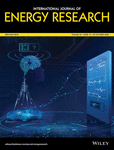Thermodynamic performance of absorption-compression hybrid refrigeration cycles based on lithium nitrate+1-butyl-3-methylimidazolium nitrate/water working fluid
Funding information: CSC Scholarship, Grant/Award Number: 201706465071; Fundamental Research Funds for the Center Universities, Grant/Award Number: FRF-TP-18-010A3; National Natural Science Foundation of China, Grant/Award Number: 51506005
Summary
In this paper, LiNO3 (lithium nitrate)-[BMIM]NO3 (1-butyl-3-methylimidazolium nitrate)/H2O is presented for absorption-compression hybrid refrigeration. The thermophysical properties and corrosion of this ternary system were measured. The performance of this hybrid system using LiNO3-[BMIM]NO3/H2O was studied and compared with those based on LiBr (lithium bromide)/H2O, LiNO3/H2O, and LiNO3-[MMIM][DMP] (1,3-dimethylimidazolium dimethylphosphate)/H2O. Results showed that the hybrid refrigeration cycles can work at much lower generator and evaporator temperatures in comparison with the pure absorption cycle. Generator temperatures of both hybrid cycles based on this working fluid were lower than those using the other working fluids. At different refrigeration temperatures, the generator temperatures of both hybrid cycles using this presented working fluid were reduced about 7 and 10 K, respectively, in comparison with those based on LiBr/H2O. Compared with other working fluids, both single- and double-effect hybrid systems using this new working fluid achieved a larger coefficient of performance around 0.88 and 1.6, respectively. Additionally, the exergetic efficiency for both hybrid cycles is also about 10% larger than that using LiBr/H2O. And this working fluid shows an excellent thermal stability below 598.32 K and acceptable high-temperature anti-corrosion to metallic materials. Moreover, the hybrid cycle using LiNO3-[BMIM]NO3/H2O of 80 kW has a shorter payback period of 5.51 years when utilizing solar energy as the driven heat source. Therefore, LiNO3-[BMIM]NO3/H2O shows great advantages in the absorption-compression hybrid cycles.




